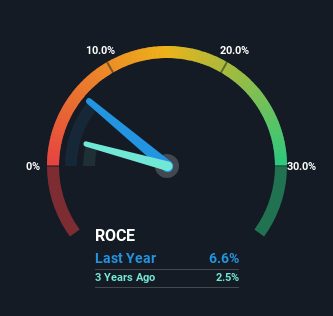- China
- /
- Transportation
- /
- SHSE:601816
The Returns At Beijing-Shanghai High-Speed Railway (SHSE:601816) Aren't Growing

If you're not sure where to start when looking for the next multi-bagger, there are a few key trends you should keep an eye out for. Ideally, a business will show two trends; firstly a growing return on capital employed (ROCE) and secondly, an increasing amount of capital employed. Ultimately, this demonstrates that it's a business that is reinvesting profits at increasing rates of return. However, after briefly looking over the numbers, we don't think Beijing-Shanghai High-Speed Railway (SHSE:601816) has the makings of a multi-bagger going forward, but let's have a look at why that may be.
Understanding Return On Capital Employed (ROCE)
If you haven't worked with ROCE before, it measures the 'return' (pre-tax profit) a company generates from capital employed in its business. The formula for this calculation on Beijing-Shanghai High-Speed Railway is:
Return on Capital Employed = Earnings Before Interest and Tax (EBIT) ÷ (Total Assets - Current Liabilities)
0.066 = CN¥18b ÷ (CN¥293b - CN¥14b) (Based on the trailing twelve months to March 2024).
So, Beijing-Shanghai High-Speed Railway has an ROCE of 6.6%. In absolute terms, that's a low return, but it's much better than the Transportation industry average of 4.3%.
View our latest analysis for Beijing-Shanghai High-Speed Railway

Above you can see how the current ROCE for Beijing-Shanghai High-Speed Railway compares to its prior returns on capital, but there's only so much you can tell from the past. If you'd like to see what analysts are forecasting going forward, you should check out our free analyst report for Beijing-Shanghai High-Speed Railway .
So How Is Beijing-Shanghai High-Speed Railway's ROCE Trending?
There are better returns on capital out there than what we're seeing at Beijing-Shanghai High-Speed Railway. Over the past five years, ROCE has remained relatively flat at around 6.6% and the business has deployed 37% more capital into its operations. Given the company has increased the amount of capital employed, it appears the investments that have been made simply don't provide a high return on capital.
The Key Takeaway
As we've seen above, Beijing-Shanghai High-Speed Railway's returns on capital haven't increased but it is reinvesting in the business. And with the stock having returned a mere 9.9% in the last three years to shareholders, you could argue that they're aware of these lackluster trends. So if you're looking for a multi-bagger, the underlying trends indicate you may have better chances elsewhere.
One more thing, we've spotted 1 warning sign facing Beijing-Shanghai High-Speed Railway that you might find interesting.
While Beijing-Shanghai High-Speed Railway may not currently earn the highest returns, we've compiled a list of companies that currently earn more than 25% return on equity. Check out this free list here.
If you're looking to trade Beijing-Shanghai High-Speed Railway, open an account with the lowest-cost platform trusted by professionals, Interactive Brokers.
With clients in over 200 countries and territories, and access to 160 markets, IBKR lets you trade stocks, options, futures, forex, bonds and funds from a single integrated account.
Enjoy no hidden fees, no account minimums, and FX conversion rates as low as 0.03%, far better than what most brokers offer.
Sponsored ContentValuation is complex, but we're here to simplify it.
Discover if Beijing-Shanghai High-Speed Railway might be undervalued or overvalued with our detailed analysis, featuring fair value estimates, potential risks, dividends, insider trades, and its financial condition.
Access Free AnalysisHave feedback on this article? Concerned about the content? Get in touch with us directly. Alternatively, email editorial-team (at) simplywallst.com.
This article by Simply Wall St is general in nature. We provide commentary based on historical data and analyst forecasts only using an unbiased methodology and our articles are not intended to be financial advice. It does not constitute a recommendation to buy or sell any stock, and does not take account of your objectives, or your financial situation. We aim to bring you long-term focused analysis driven by fundamental data. Note that our analysis may not factor in the latest price-sensitive company announcements or qualitative material. Simply Wall St has no position in any stocks mentioned.
Have feedback on this article? Concerned about the content? Get in touch with us directly. Alternatively, email editorial-team@simplywallst.com
About SHSE:601816
Beijing-Shanghai High-Speed Railway
Beijing-Shanghai High-Speed Railway Co., Ltd.
Excellent balance sheet with proven track record.
Market Insights
Community Narratives



